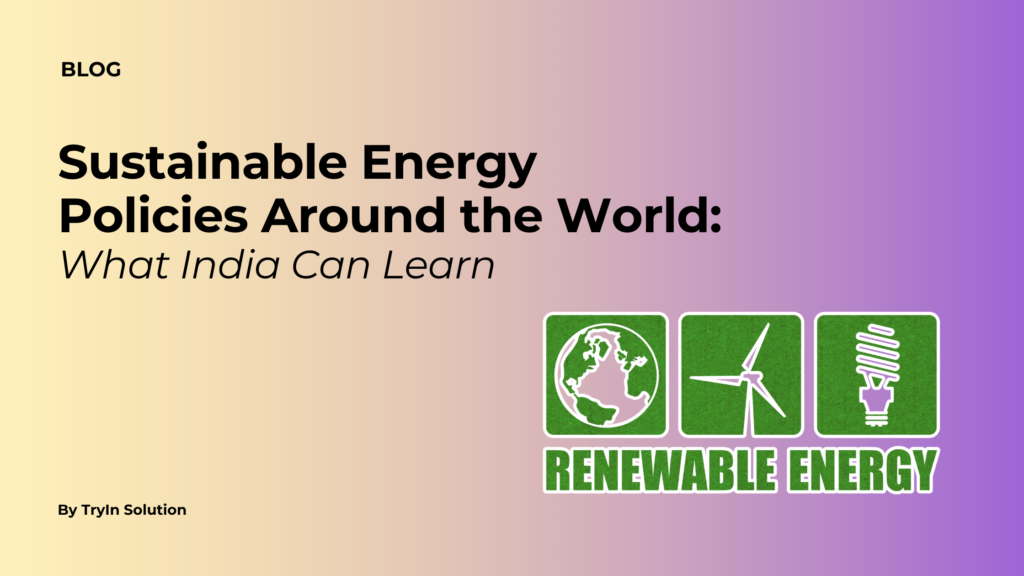
In a world grappling with climate change, energy security and economic transformation, sustainable energy policy is no longer an optional topic—it’s a strategic requisite. For a rapidly developing nation such as India, there is much to learn from the policy frameworks adopted by other countries. At TryIn Solution we believe that understanding global best practices in sustainable energy can help businesses, supply-chains and government-linked enterprises design smarter, more future-proof energy strategies.
What do we mean by “sustainable energy policies”?
In essence, sustainable energy policy refers to governmental and regulatory frameworks that foster three key pillars:
- Access to modern, clean energy for all
- Energy-efficiency and reduced waste
- Large-scale deployment of low-carbon or renewable sources
According to the World Bank, these three dimensions form the foundation of what they call the “sustainable energy” agenda. (c2e2.unepccc.org)
Select global policy case-studies
European Union (EU)
The European Commission’s “Green Deal” and associated directives provide a strong example of an integrated approach: prioritising energy efficiency, renewable-based power, and a digitalised, interconnected energy market. (Wikipedia) The EU’s recent revision of its renewable-energy directive raised the binding target for 2030 to at least 42.5% of the energy mix. (Wikipedia)
Key takeaway for India: Binding targets + integrated markets + efficiency mandates = sustainable system transformation.
United States
According to global policy trackers, the US has introduced substantial clean-energy statutes, including expansive tax-credits, incentives for manufacturing clean-energy technologies and stricter energy-performance standards. (ecopowerhub.com)
Key takeaway: Incentivise domestic manufacturing + link policy to industrial competitiveness.
China and other emerging markets
The world’s major developing economies are also advancing in the sustainable energy domain. China, for example, has rapidly ramped capacity for solar, wind and batteries as part of its green industrial push. (oilandgasmiddleeast.com)
Key takeaway: Scale matters – ambitious deployment backed by policy helps create new supply-chain dynamics.
What can India learn – and how can businesses benefit?
India is uniquely positioned: strong growth, burgeoning demand, and a national commitment towards cleaner energy. By internalising global policy lessons, the following areas can yield particular value:
1. Define clear, binding targets and time-frames
Global peers show that when a government sets measurable, enforced goals (e.g., renewable share by 2030), the private sector plans invest accordingly. India’s next step is to align business planning with such mandates.
2. Integrate energy efficiency with supply-chain strategy
Efficiency improvements aren’t just about appliances—they’re about manufacturing, logistics and operations. Europe’s success shows that coupling efficiency with renewable supply yields win–win outcomes.
3. Encourage domestic clean-tech manufacturing
By learning from US/China policy models, India can create incentives for manufacturing of solar modules, batteries, storage solutions. Businesses that align early will capture upstream value.
4. Design policy tools for businesses & investors
Stable incentives, transparent regulations, and predictable frameworks reduce risk for corporate investment in sustainable energy. This drives faster adoption and deeper integration of renewables in business operations.
5. Focus on system integration and flexibility
As renewables grow, grid flexibility, storage and demand-response become vital. India’s policy should factor in the “next-wave” beyond just generation—exactly as advanced markets are doing. (United Nations)
Businesses that anticipate this shift (e.g., investing in storage, smart-grid, flexible loads) gain competitive edge.
Role of TryIn Solution for Your Business
At TryIn Solution we help you translate global policy insights into local business strategies:
- Mapping out policy-landscape and incentives specific to India’s states and industries.
- Conducting energy-strategy planning that aligns with sustainable energy mandates and corporate sustainability goals.
- Advising on capex-vs-opex models, ensuring your investments in renewables or efficiency tie directly into cost-savings, compliance and brand value.
Conclusion
The global thrust toward sustainable energy is more than a trend—it is structural. Countries that are leading have adopted smart, coherent policies that couple ambition with implementation. For India—and for businesses operating here—the opportunity lies in learning from those frameworks and moving quickly.
By adopting policy-driven approaches to sustainable energy, businesses gain resilience, cost-advantage and future-proof positioning. At TryIn Solution, our goal is to help you turn policy insight into actionable strategy. Let’s work together to make India not just a follower—but a leader in the sustainable energy transition.